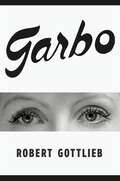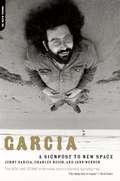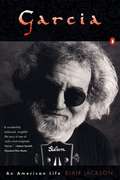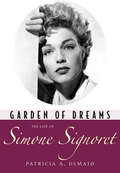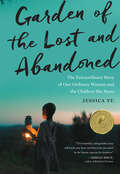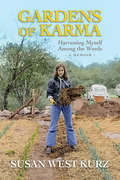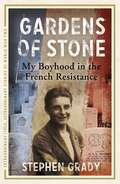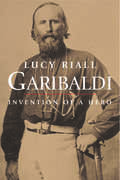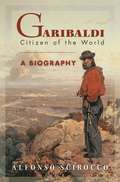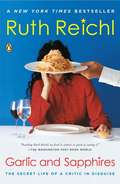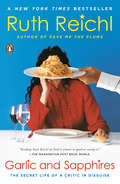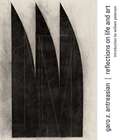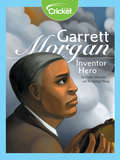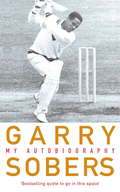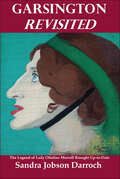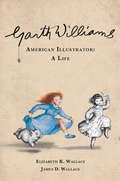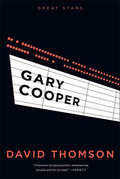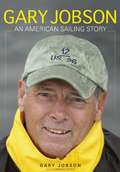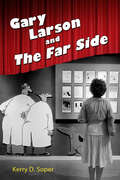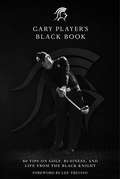- Table View
- List View
Garbo
by Robert GottliebA New York Times Book Review Editors' Choice | One of Literary Hub's most anticipated books of 2021Award-winning master critic Robert Gottlieb takes a singular and multifaceted look at the life of silver screen legend Greta Garbo, and the culture that worshiped her.“Wherever you look in the period between 1925 and 1941,” Robert Gottlieb writes in Garbo, “Greta Garbo is in people’s minds, hearts, and dreams.” Strikingly glamorous and famously inscrutable, she managed, in sixteen short years, to infiltrate the world’s subconscious; the end of her film career, when she was thirty-six, only made her more irresistible. Garbo appeared in just twenty-four Hollywood movies, yet her impact on the world—and that indescribable, transcendent presence she possessed—was rivaled only by Marilyn Monroe’s. She was looked on as a unique phenomenon, a sphinx, a myth, the most beautiful woman in the world, but in reality she was a Swedish peasant girl, uneducated, naïve, and always on her guard. When she arrived in Hollywood, aged nineteen, she spoke barely a word of English and was completely unprepared for the ferocious publicity that quickly adhered to her as, almost overnight, she became the world’s most famous actress.In Garbo, the acclaimed critic and editor Robert Gottlieb offers a vivid and thorough retelling of her life, beginning in the slums of Stockholm and proceeding through her years of struggling to elude the attention of the world—her desperate, futile striving to be “left alone.” He takes us through the films themselves, from M-G-M’s early presentation of her as a “vamp”—her overwhelming beauty drawing men to their doom, a formula she loathed—to the artistic heights of Camille and Ninotchka (“Garbo Laughs!”), by way of Anna Christie (“Garbo Talks!”), Mata Hari, and Grand Hotel. He examines her passive withdrawal from the movies, and the endless attempts to draw her back. And he sketches the life she led as a very wealthy woman in New York—“a hermit about town”—and the life she led in Europe among the Rothschilds and men like Onassis and Churchill. Her relationships with her famous co-star John Gilbert, with Cecil Beaton, with Leopold Stokowski, with Erich Maria Remarque, with George Schlee—were they consummated? Was she bisexual? Was she sexual at all? The whole world wanted to know—and still wants to know.In addition to offering his rich account of her life, Gottlieb, in what he calls “A Garbo Reader,” brings together a remarkable assembly of glimpses of Garbo from other people’s memoirs and interviews, ranging from Ingmar Bergman and Tallulah Bankhead to Roland Barthes; from literature (she turns up everywhere—in Hemingway’s For Whom the Bell Tolls, in Evelyn Waugh, Graham Greene, and the letters of Marianne Moore and Alice B. Toklas); from countless songs and cartoons and articles of merchandise. Most extraordinary of all are the pictures—250 or so ravishing movie stills, formal portraits, and revealing snapshots—all reproduced here in superb duotone. She had no personal vanity, no interest in clothes and make-up, yet the story of Garbo is essentially the story of a face and the camera. Forty years after her career ended, she was still being tormented by unrelenting paparazzi wherever she went.Includes Black-and-White Photographs
Garcia: A Signpost to New Space
by Jann Wenner Jerry Garcia Charles ReichJerry Garcia (1942-1995) is an American icon. The guitarist and de facto leader of the Grateful Dead was a gregarious talker, keenly engaged with the new world exploding around him. In 1972, Garcia was visited by Charles Reich, a Yale law professor, and Jann Wenner, the founder of Rolling Stone. Garcia was just thirty-one years old but already viewed--to his lasting dismay--as a social avatar for the new sensibility sweeping the land, an anarchist streak with a populist undercurrent that had roots in Ken Kesey's pranksters, the writers of the Beat Generation, and the libertine tradition of the American transcendentalists. In this interview, Garcia reveals how he is a combination of these and other influences, a high-school dropout and autodidact blessed with a gift for eloquent turns of phrase and a refreshing directness. He speaks of the saga of the Grateful Dead and his hoodlum youth growing up in San Francisco's Mission district. He delves into fascinating discourses on the music that shaped his own playing and writing, and freely discusses his use of drugs and explains why he felt it was important to stay high. Like the Grateful Dead's best music, Garcia: A Signpost to New Space is familiar, friendly, and inviting.
Garcia: An American Life
by Blair JacksonHe was there when Dylan went electric, when a generation danced naked at Woodstock, and when Ken Kesey started experimenting with acid. Jerry Garcia was one of the most gifted musicians of all time, and he was a member of one of the most worshiped rock 'n' roll bands in history. Now, Blair Jackson, who covered the Grateful Dead for twenty-five years, gives us an unparalleled portrait of Garcia--the musical genius, the brilliant songwriter, and ultimately, the tortured soul plagued by his own addiction. With more than forty photographs, many of them previously unpublished, Garcia: An American Life is the ultimate tribute to the man who, Bob Dylan said, "had no equal."
Garden of Dreams: The Life of Simone Signoret (Hollywood Legends Series)
by Patricia A. DemaioThe incomparable Simone Signoret (1921-1985), one of the grand actresses of the twentieth century and one of France's most notable stars, considered herself the “oldest discovery” in Hollywood. After years of block-listing during the McCarthy era, she was thirty-eight years old when she entered Hollywood through the back door in the 1959 British blockbuster Room at the Top. Her portrayal of the endearing Alice Aisgill earned her the Academy Award in 1960, the first French actor to win a coveted Oscar. Though a latecomer to Hollywood, Signoret was already an international star who had survived the Nazi occupation of Paris, emerging in 1945 as a beautiful, promising actress capable of communicating more emotion through body language than dialogue alone could achieve. She gained a reputation as the thinking man's sex symbol and in several films portrayed prostitutes with subtlety and depth. She was fiercely protective of her privacy. But after winning the Oscar, she was dragged through the gutter when her second husband, Yves Montand, had a widely publicized affair with Marilyn Monroe. Many attributed her rapid aging and alcoholism to this betrayal. She endured this perception in silence, all the while demonstrating a remarkable capacity to reinvent herself as a bestselling author, respected social activist, and revered actress who remained in the cinema, her “garden of dreams,” for over four decades. Patricia A. DeMaio combines Signoret's courageous story with Montand's biography to reveal new information and insight into Signoret's humanitarian efforts and the vibrant film career that sustained her.
Garden of the Lost and Abandoned: The Extraordinary Story of One Ordinary Woman and the Children She Saves
by Jessica YuThe problem by most lights is overwhelming: at least 5,000 children live on the streets of Uganda&’s capital city of Kampala. Some forget the names of their villages. The youngest may not know the names of their parents. But Gladys Kalibbala—part journalist, part detective, part Good Samaritan—does not hesitate to dive into difficult or even dangerous situations to aid a child. Author of a newspaper column called &“Lost and Abandoned,&” she is a resource that police and others turn to when they stumble across a stranded kid with a hidden history. Jessica Yu delivers an acutely observed story of this hardnosed and warmhearted woman, the children she helps, and the twists of fate they experience together. The subplot of Gladys&’s garden—her precarious dream of providing a home and livelihood for her vulnerable charges—adds fascinating depth. Garden of the Lost and Abandoned chronicles one woman&’s altruism, both ordinary and extraordinary, in a way that is impossible to forget, and impossible not to take to heart.
Gardens of Karma: Harvesting Myself Among the Weeds, A Memoir
by Susan West KurzIt Began in a Simple Garden . . . and Led to a Spiritual Path. Susan West Kurz's earliest memories began in a garden, where she nurtured herbs and colorful flowers, nibbled sun-drenched vegetables and ripe berries, and danced with her doll, Pinocchio. Later, she landed in another garden, that one in Germany, where she shaped her budding interest into a hugely successful career for international organic and natural skin care products. But for decades, Susan was steeped in another role-one of enabler, support system, and overall back-up singer to the alcoholics who were center stage in her life. The pain of that disease ultimately led her to Anthroposophy, her spiritual path, where she soon recognized she had been headed all along. On her subsequent journey to health and freedom, Susan continues to find inner peace in a garden.
Gardens of Stone: My Boyhood In The French Resistance (Extraordinary Lives, Extraordinary Stories of World War Two #6)
by Michael Wright Stephen GradyAn extraordinary wartime memoir, combining the best kind of adventure story with a coming of age testimony of unforgettable resonance and poignancy. September 2011, Halkidiki, Northern Greece. A solitary 86 year-old man gazes across an Aegean headland, knowing that he must finally confront his past. He begins to write... September 1939, Nieppe, Northern France. 14 year-old Stephen is living with his family, 25 kilometres from Ypres. His French mother battles with her encroaching blindness. Failing to escape the advancing German army, his English father can no longer look after the war graves that cast so heartbreaking a shadow across the region. Stephen and his friend Marcel embark upon their great adventure: collecting souvenirs from strafed convoys and crashed Messerschmitts. But their world turns dark when arrested and imprisoned for sabotage and threatened with deportation or the firing squad. Upon his release, and still only 16, Stephen is recruited by the French Resistance. Growing up under the threat of imminent betrayal, he learns the arts of clandestine warfare, and - in a moment that haunts him still - how to kill... Such was the impact of Stephen Grady's work for the French Resistance, (especially during the countdown to D-Day and its bloody aftermath) that he was awarded the Croix de Guerre and the American Medal of Freedom.
Gardens of Stone: My Boyhood in the French Resistance
by Michael Wright Stephen GradyAn extraordinary wartime memoir, combining the best kind of adventure story with a coming of age testimony of unforgettable resonance and poignancy. September 2011, Halkidiki, Northern Greece. A solitary 86 year-old man gazes across an Aegean headland, knowing that he must finally confront his past. He begins to write... September 1939, Nieppe, Northern France. 14 year-old Stephen is living with his family, 25 kilometres from Ypres. His French mother battles with her encroaching blindness. Failing to escape the advancing German army, his English father can no longer look after the war graves that cast so heartbreaking a shadow across the region. Stephen and his friend Marcel embark upon their great adventure: collecting souvenirs from strafed convoys and crashed Messerschmitts. But their world turns dark when arrested and imprisoned for sabotage and threatened with deportation or the firing squad. Upon his release, and still only 16, Stephen is recruited by the French Resistance. Growing up under the threat of imminent betrayal, he learns the arts of clandestine warfare, and - in a moment that haunts him still - how to kill... Such was the impact of Stephen Grady's work for the French Resistance, (especially during the countdown to D-Day and its bloody aftermath) that he was awarded the Croix de Guerre and the American Medal of Freedom.
Gardens of Stone: My Boyhood in the French Resistance (Extraordinary Lives, Extraordinary Stories of World War Two #6)
by Michael Wright Stephen GradyAn extraordinary wartime memoir, combining the best kind of adventure story with a coming of age testimony of unforgettable resonance and poignancy.September 2011, Halkidiki, Northern Greece. A solitary 86 year-old man gazes across an Aegean headland, knowing that he must finally confront his past. He begins to write...September 1939, Nieppe, Northern France. 14 year-old Stephen is living with his family, 25 kilometres from Ypres. His French mother battles with her encroaching blindness. Failing to escape the advancing German army, his English father can no longer look after the war graves that cast so heartbreaking a shadow across the region. Stephen and his friend Marcel embark upon their great adventure: collecting souvenirs from strafed convoys and crashed Messerschmitts. But their world turns dark when arrested and imprisoned for sabotage and threatened with deportation or the firing squad. Upon his release, and still only 16, Stephen is recruited by the French Resistance. Growing up under the threat of imminent betrayal, he learns the arts of clandestine warfare, and - in a moment that haunts him still - how to kill... Such was the impact of Stephen Grady's work for the French Resistance, (especially during the countdown to D-Day and its bloody aftermath) that he was awarded the Croix de Guerre and the American Medal of Freedom.(P)2013 Hodder & Stoughton
Garibaldi
by Lucy RiallGiuseppe Garibaldi, the Italian revolutionary leader and popular hero, was among the best-known figures of the nineteenth century. This book seeks to examine his life and the making of his cult, to assess its impact, and understand its surprising success.For thirty years Garibaldi was involved in every combative event in Italy. His greatest moment came in 1860, when he defended a revolution in Sicily and provoked the collapse of the Bourbon monarchy, the overthrow of papal power in central Italy, and the creation of the Italian nation state. It made him a global icon, representing strength, bravery, manliness, saintliness, and a spirit of adventure. Handsome, flamboyant, and sexually attractive, he was worshiped in life and became a cult figure after his death in 1882.Lucy Riall shows that the emerging cult of Garibaldi was initially conceived by revolutionaries intent on overthrowing the status quo, that it was also the result of a collaborative effort involving writers, artists, actors, and publishers, and that it became genuinely and enduringly popular among a broad public. The book demonstrates that Garibaldi played an integral part in fashioning and promoting himself as a new kind of "charismatic" political hero. It analyzes the way the Garibaldi myth has been harnessed both to legitimize and to challenge national political structures. And it identifies elements of Garibaldi's political style appropriated by political leaders around the world, including Mussolini and Che Guevara.
Garibaldi: Citizen of the World: A Biography
by Alfonso SciroccoWhat adventure novelist could have invented the life of Giuseppe Garibaldi? The revolutionary, soldier, politician, and greatest figure in the fight for Italian unification, Garibaldi (1807-1882) brought off almost as many dramatic exploits in the Americas as he did in Europe, becoming an international freedom fighter, earning the title of the "hero of two worlds," and making himself perhaps the most famous and beloved man of his century. Alfonso Scirocco's Garibaldi is the most up-to-date, authoritative, comprehensive, and convincing biography of Garibaldi yet written. In vivid narrative style and unprecedented detail, and drawing on many new sources that shed fresh light on important events, Scirocco tells the full story of Garibaldi's fascinating public and private life, separating its myth-like reality from the outright myths that have surrounded Garibaldi since his own day. Scirocco tells how Garibaldi devoted his energies to the liberation of Italians and other oppressed peoples. Sentenced to death for his role in an abortive Genoese insurrection in 1834, Garibaldi fled to South America, where he joined two successive fights for independence--Rio Grande do Sul's against Brazil and Uruguay's against Argentina. He returned to Italy in 1848 to again fight for Italian independence, leading seven more campaigns, including the spectacular capture of Sicily. During the American Civil War, Abraham Lincoln even offered to make him a general in the Union army. Presenting Garibaldi as a complex and even contradictory figure, Scirocco shows us the pacifist who spent much of his life fighting; the nationalist who advocated European unification; the republican who served a king; and the man who, although compared by contemporaries to Aeneas and Odysseus, refused honors and wealth and spent his last years as a farmer.
Garlic and Sapphires: The Secret Life of a Critic in Disguise
by Ruth ReichlReichl knows that, as the most important food critic in the country, she must be anonymous - a charge she took very seriously by assuming the guise of a series of eccentric personalities.
Garlic and Sapphires: The Secret Life of a Critic in Disguise
by Ruth ReichlGARLIC AND SAPPHIRES is Ruth Reichl's riotous account of the many disguises she employs to dine anonymously. There is her stint as Molly Hollis, a frumpy blond with manicured nails and an off-beige Armani suit that Ruth takes on when reviewing Le Cirque. The result: her famous double review of the restaurant: first she ate there as Molly; and then as she was coddled and pampered on her visit there as Ruth, New York Times food critic.What is even more remarkable about Reichl's spy games is that as she takes on these various disguises, she finds herself changed not just superficially, but in character as well. She gives a remarkable account of how one's outer appearance can very much influence one's inner character, expectations, and appetites.As she writes, "Every restaurant is a theater . . . even the modest restaurants offer the opportunity to become someone else, at least for a little while." GARLIC AND SAPPHIRES is a reflection on personal identity and role playing in the decadent, epicurean theaters of the restaurant world.
Garo Z. Antreasian: Reflections on Life and Art
by Garo Z. AntreasianGaro Z. Antreasian (b. 1922) belongs to the great generation of innovators in mid-twentieth-century American art. While influenced by a variety of European artists in his early years, it was his involvement with Tamarind Lithography Workshop starting in 1960 that transformed his work. As Tamarind&’s founding technical director, he revolutionized the medium of lithography. He discovered how to manipulate the spontaneous possibilities of lithography in the manner of the Abstract Expressionist painters. In addition to reflecting on his work, he writes movingly about his Armenian heritage and its importance in his art, his teaching, and his love affair with all sorts of artistic media. Illustrating his drawings, paintings, and prints, this book reveals Antreasian as a major American artist.This book was made possible in part by generous contributions from the Frederick Hammersley Foundation and Gerald Peters Gallery.
Garrett Morgan: Inventor Hero
by Paula MorrowGarrett Morgan was an inventor concerned for the well-being of other people. His inventions included the safety hood gas mask and signals that set the standard for today's traffic lights. It is easy to see that the lives of many people were made better or saved by Garrett Morgan’s inventions.
Garrett Morgan: The Man Behind the Mask (Fountas & Pinnell Classroom, Guided Reading)
by Harold WilliamsNIMAC-sourced textbook. In a tunnel deep under Lake Erie, a massive explosion had trapped a group of workers. Unless rescue came soon, the men were sure to die. Their only hope for survival was if Garrett Morgan arrived with his remarkable new invention.
Garry Sobers: My Autobiography
by Garfield SobersGarry Sobers is a cricketing legend, the greatest all-rounder of all time. In this revealing and honest autobiography, Sobers talks about his upbringing and about the tragic accident that inspired him throughout his career. He explains how he helped the West Indies to become the most feared cricketing nation in the world, setting them on a course of success that would run for another 20 years. He also provides authoritative views on the current state of the game and the future of cricket.
Garry Sobers: My Autobiography
by Garfield SobersGarry Sobers is a cricketing legend, the greatest all-rounder of all time. In this revealing and honest autobiography, Sobers talks about his upbringing and about the tragic accident that inspired him throughout his career. He explains how he helped the West Indies to become the most feared cricketing nation in the world, setting them on a course of success that would run for another 20 years. He also provides authoritative views on the current state of the game and the future of cricket.
Garsington Revisited: The Legend of Lady Ottoline Morrell Brought Up-to-Date
by Sandra Jobson DarrochLady Ottoline Morrell was the foremost host of the Bloomsbury set, offering sustenance and friendship to Virginia Woolf, Vanessa Bell, TS Eliot, DH Lawrence, Duncan Grant and her lover Bertrand Russell, to name but a few. This book is a revised and updated edition of the author's original biography of Ottoline first published in 1975 worldwide. It has been updated, with vignettes about her sources, including lunch at ?xml:namespace prefix = st1 ns = "urn:schemas-microsoft-com:office:smarttags" / Charleston with Duncan Grant, and a ship's tumbler of sherry with David Garnett as a prelude to discussing "skeletons in Ottoline's cupboard"). Her sources in Texas where she read more than 8,000 letters to Ottoline including 2,500 letters from Bertrand Russell, can now be located in new footnotes. Darroch remains as impressed as ever by Ottoline's courage and determination to forgo the comfortable life of an aristocrat to mix with – and champion – some of the 20th century's leading artists and writers. The definitive biography.
Garth Brooks: Straight from the Heart
by Edward TallmanA short biography of country music/pop singer Garth Brooks which includes some family background, the singer's school days, marriage, musical career, choice of and feelings about music and awards. It concludes shortly after the birth of his first daughter, Taylor in 1992. Contains a discography, index, all picture captions and descriptions of most pictures
Garth Williams, American Illustrator: A Life
by Elizabeth K. Wallace James D. WallaceOpen the pages of so many children’s classics—Stuart Little, Charlotte’s Web, Mister Dog, The Cricket in Times Square, The Rescuers, the Little House books—and you will see page after page of the artistry that brought those stories to life. And behind the illustrations sparking the imagination of generations was a man who had an extraordinary existence.Born in New York City in 1912, Williams was educated in England and trained on the continent. After enduring the Blitz in London, he returned to New York, where he encountered the vibrant art and cultural scene of the 1940s. He made his home first in New York, then Aspen, and finally Guanajuato, Mexico and was married four times. During his life he met people who shaped and exemplified the twentieth century: Winston Churchill, E. B. White and Ursula Nordstrom, Laura Ingalls Wilder, and countless more.This is a biography of Garth Williams as an artist and an illustrator. It is the story of how his journey led him from winning sculpture awards at the Royal College of Art in London, to capturing the essence of frontier life in the American West, to rendering the humanity of beloved animal characters. The biography also explores the historical context that affected Williams’ life and art, both in the old world and the new. Against the frenetic pace of post-war suburbanization, Williams’ illustrations nurtured a connection with the animal world and with a vanishing agrarian life. By tapping into American themes, Williams spoke to a postwar yearning for simplicity.Complete with more than 60 illustrations, this is the first full biography of Garth Williams written with the help and cooperation of his family.
Gary Cooper (Great Stars)
by David Thomson"Cooper was heroic, of course, in his own mind as much as in his scripts. He was manly, tall, ruggedly handsome. He was a man for a fight." On screen Gary Cooper was the ultimate all-American hero: lean, laconic, and masculine, a lone sheriff battling his enemies in High Noon, or a tough individualist in The Fountainhead. Off-screen he bedded a host of leading ladies and carefully honed his image, making hundreds of movies and winning two Oscars in the process. The acclaimed film writer David Thomson explores the career and the contradictions of "Coop," the star who lived the dream in the golden age of Hollywood.
Gary Jobson
by Gary Jobson Cynthia GossFor Gary Jobson-the three-time All American sailor, America's Cup winner, Fastnet Race winner, and ESPN sailing commentator since 1985-sailing is life. In 2003, he was diagnosed with lymphoma, and here he relays the tumultuous diagnosis and treatments endured before the cancer went into remission. Through remission he remembers how his life has intertwined with some of the greatest sailors, how the sport has changed since his childhood, how the public view of sailing went through a revolutionary change with the advent of ESPN, how sailing can create lasting bonds of friendship that endure, and how sailing offers everything from the highest of adventures to the simplest of pleasures. This uplifting memoir also includes a foreword by Ted Turner.
Gary Larson and The Far Side (Great Comics Artists Series)
by Kerry D. SoperKerry D. Soper reminds us of The Far Side's groundbreaking qualities and cultural significance in Gary Larson and "The Far Side." In the 1980s, Gary Larson (b. 1950) shook up a staid comics page by introducing a set of aesthetic devices, comedic tones, and philosophical frames that challenged and delighted many readers, even while upsetting and confusing others. His irreverent, single panels served as an alternative reality to the tame comedy of the family-friendly newspaper comics page, as well as the pervasive, button-down consumerism and conformity of the Reagan era.In this first full study of Larson's art, Soper follows the arc of the cartoonist's life and career, describing the aesthetic and comedic qualities of his work, probing the business side of his success, and exploring how The Far Side brand as a whole--with its iconic characters and accompanying set of comedic and philosophical frames--connected with its core readers. In effect, Larson reinvented his medium by creatively working within, pushing against, and often breaking past institutional, aesthetic, comedic, and philosophical parameters.Due to the comic's great success, it opened the door for additional alternative voices in comics and other popular mediums. With its intentionally awkward, minimalistic lines and its morbid humor, The Far Side expanded Americans' comedic palette and inspired up-and-coming cartoonists, comedians, and filmmakers. Soper re-creates the cultural climate and media landscape in which The Far Side first appeared and thrived, then assesses how it impacted worldviews and shaped the comedic sensibilities of a generation of cartoonists, comedy writers, and everyday fans.
Gary Player's Black Book: 60 Tips on Golf, Business, and Life from the Black Knight
by Lee Trevino Gary PlayerGary Player's Black Book contains fifty questions and detailed responses from eighteen-time major winner Gary Player. The book, divided into three parts, focuses on specific scenarios and problems that arise in golf, life, and business.In the first section on golf, topics include putting, scoring, etiquette, the mental side of the game, and fitness and nutrition. In the section on life, Player, the father of six and grandfather to twenty-two, addresses issues such as parenting, who to turn to when in need of advice, and more. Finally, in the section on business, he details how to deal with competition, among other topics. Player responds to questions such as: Golf: How do I play a bunker shot from a plugged lie? Life: I feel like I’ve lost the passion for what I do. How do I get that back? Business: When people criticize my work I take it very personally. How do you handle criticism?The 2012 recipient of the PGA Tour Lifetime Achievement Award, Player draws from both on and off the course experiences dealing with competitors, businesspeople, and family. In doing so, he offers a unique glimpse into handling adversity with regard to these relationships. The advice that he offers is invaluable to fans of all ages.
